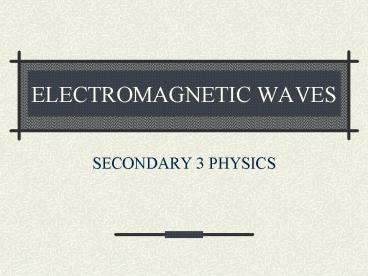ELECTROMAGNETIC WAVES - PowerPoint PPT Presentation
1 / 19
Title:
ELECTROMAGNETIC WAVES
Description:
They have a large amount of energy Energy carried by electromagnetic radiation Energy frequency We calculate the energy of the radiation using: E ... – PowerPoint PPT presentation
Number of Views:153
Avg rating:3.0/5.0
Title: ELECTROMAGNETIC WAVES
1
ELECTROMAGNETIC WAVES
- SECONDARY 3 PHYSICS
2
WHAT ARE EM WAVES?
- Electromagnetic waves (EM waves for short) are
waves that can travel in a vacuum. - These waves are created by the vibration of an
electric charge.
3
- EM radiation is a wave that is produced as
follows - When charges accelerate, they produce a changing
magnetic field. - This changing magnetic field creates a changing
electric field at 90 to it. - The electric field now causes a changing magnetic
field at right angles to it. - The magnetic and electric fields are able to
generate each other without any decrease in
strength if the fields move at 3 ? 108 m.s-1.
4
(No Transcript)
5
Electromagnetic Spectrum
- It is a group of different electromagnetic waves.
- There are 7 components in the spectrum.
6
Electromagnetic Spectrum
- Gamma rays
- X rays
- Ultraviolet
- Visible light
- Infra-red
- Microwaves
- Radio waves
Highest frequency Shortest wavelength
Lowest frequency Longest wavelength
7
Uses of Gamma Rays
- Kill cancer cells
- Study the nucleus in atoms
8
Uses of X-rays
- Take pictures of bones in the body
- Study the crystal structure of crystalline
substances - Check for cracks in metal plates
9
Uses of Ultraviolet
- Detect counterfeit notes
- Gives the clothes a glow effect in discotheques
- Sun-tanning
- Sterilise medical equipment
10
Uses of Visible Light
- Enable us to see things
- Photosynthesis in plants
11
Uses of Infra-red
- Heating
- Haze photography
12
Uses of Microwaves
- Radar communication
- Analysis of the molecular and atomic structure
- Telephone communications
13
Uses of Radio Waves
- Radar communications
- TV and radio broadcasting
14
Common Properties of EM Waves
- All transverse waves
- All travel at the speed of light. (3 x 108 m/s)
- Can travel through solid, liquid, gas and vacuum
- Obey the laws of reflection and refraction
- All can be absorbed and emitted by matter
- The wave equation is applicable to all
15
Penetrating ability of electromagnetic radiation
- The ability of EM radiation to go through
(penetrate) bone, glass or concrete depends on
the energy of the radiation and then also on the
frequency of the radiation. - Radio waves have the lowest frequency of EM
radiation and thereby the lowest energy. They are
not able to travel through the ground, therefore
we cannot receive a radio signal underground. The
radio waves are strongly diffracted (bent) around
objects, while the shorter radio waves are
reflected by the charged upper atmosphere
fluctuate because of the changing reflecting
ability of this layer.
16
- Microwaves have a low penetrative ability. Cell
phone masts that use microwaves must have no
obstructions in between them. - Infrared radiation has low energy. It is able to
warm the skin but cannot penetrate through the
skin. - Ultraviolet radiation has a frequency higher than
violet light in the visible spectrum. The energy
is such that it is harmful to the eyes and can
cause the skin to tan.
17
- X-rays have a high energy and a high penetrative
ability. They can penetrate the soft tissue in
the body but cannot go through the bone. - Gamma rays can pass through a few centimetres of
lead or concrete. They have a large amount of
energy
18
Energy carried by electromagnetic radiation
- Energy ? frequency
- We calculate the energy of the radiation using
- E h ? f
- Where E is the energy of the radiation measured
in Joules (J) - h is plancks constant and has a value of
- 6,63 ? 10-34 J?s
- f is the frequency of the radiation measured in
hertz (Hz)
19
- Since f c/ ?
- To calculate the energy of the photon, we use
the following equation - E hc/ ?
- Where E Energy in joules (J)
- h planks constant (6,6 ? 10-34 J.s)
- f frequency in hertz (Hz)
- ? wavelength in metres (m)
- c speed of light (3 ? 108 m.s-1)































